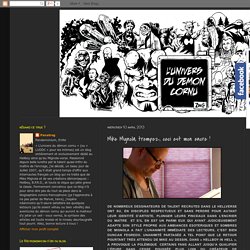

‘Hellboy in Hell’ is the Comic Mike Mignola Will Be Drawing for the Rest of His Life [Interview] On sale now from Dark Horse is Hellboy in Hell #1, a comic that marks not just a new creative achievement in the already superlative oeuvre of cartoonist Mike Mignola and a return to drawing the main Hellboy story after several years away, but also the beginning of a new and carefully considered phase of his professional career.
![‘Hellboy in Hell’ is the Comic Mike Mignola Will Be Drawing for the Rest of His Life [Interview]](http://cdn.pearltrees.com/s/pic/th/hellboy-mignola-interview-98932140)
The story finds Mignola’s popular red-skinned hero from the infernal realm come to the end of a corporeal existence that’s included achievements as the world’s best paranormal investigator, an introspective wanderer and a champion of destiny, and take the first steps into a world that Mignola’s meticulously designed to serve as Hellboy’s home for the foreseeable future. But as Mignola told ComicsAlliance in this candid interview conducted in advance of his signing and exhibition at Things From Another World in Portland, Orgegon this weekend, Hell is where the artist himself will be happy to work until the day he can no longer make comics. Artist August: Mike Mignola [Art Feature] Mike Mignola is one of the most iconic artists working in comics today.
![Artist August: Mike Mignola [Art Feature]](http://cdn.pearltrees.com/s/pic/th/multiversity-mignola-feature-98792549)
So much of what he’s done has rippled through the industry, influencing the way countless artists approach their craft. Not only in terms of his idiosyncratic approach to cartooning, but also in how his comics are released. He became synonymous with the series of mini-series, many people referring to it as ‘the Mignola model’ of publishing. His measured approach to storytelling was seen as a successful way for others to tell their own stories. Creators like David Peterson have credited Mignola with providing a template for independent comics publishing. But publishing practices won’t get you an Artist August spotlight. Mignola’s art has, over many years of refinement, become almost gestural in its storytelling. If you look at Mignola’s pencils, you’ll see that they are far more detailed than the final published art. The pacing of Mignola’s pages are also of note here. Hellboy, doing that thing he does.
Mike Mignola, trempez, ceci est mon encre ! Le récit mignolien use régulièrement du mode « répétitif » (procédé - comme son nom le laisse supposer - qui consiste à raconter plusieurs fois ce qui s’est passé une seule fois).

Cette caractéristique narratologique sert tout particulièrement le dessein d’un auteur dont l’ambition ne se résume pas à livrer une suite d’histoires de qualité, mais bien à créer un univers foisonnant et aux multiples ramifications et néanmoins cohérent et homogène. Un tel projet, cette cohérence, cette homogénéité, nécessitent des scènes, voire des plans clés, qui, repris maintes fois dans des contextes différents (sous forme de flashbacks notamment), éclaireront l’action présente ou seront eux-mêmes éclaircis et enrichis d’un sens nouveau. Ainsi la dague ensanglantée tombant bruyamment sur un sol entouré de ténèbres. Ainsi l’annonce faite à Kate par un Hellboy mélancolique et en quête de sens, de son départ du B.P.R.D. pour l’Afrique, dans un décor montagneux et grandiose. B.P.R.D. Russia : iconique, figuratif et abstrait. Un grand merci à Bernard Dato pour cette ananlyse du travail de Dave Johnson sur la couverture du premier numéro de B.P.R.D.
Hell on Earth : Russia. L'élaboration d'une couverture est un art à part entière. L'image existe par elle-même (elle n'est pas l'élément d'une séquence comme dans une planche) mais doit dans le même temps renvoyer à une narration. Elle doit anticiper, contenir, suggérer – et sans la dévoiler – cette narration séquentielle qu'elle présente. Un art à part entière. Dave Johnson excelle dans cet art. Première image : Cachez les quatre doigts blancs de la main. Cachez à présent toute la main et l'anneau qui l'enserre: ce sont les chaînes blanches et noires qui apparaissent alors comme des formes abstraites. Récapitulons: cette première étape contient de l'abstraction picturale et de l'iconique. Seconde image : Dave Johnson a ajouté à son dessin du bras un fond en deux plans (personnages et décor), dont le style est plutôt simplifié.